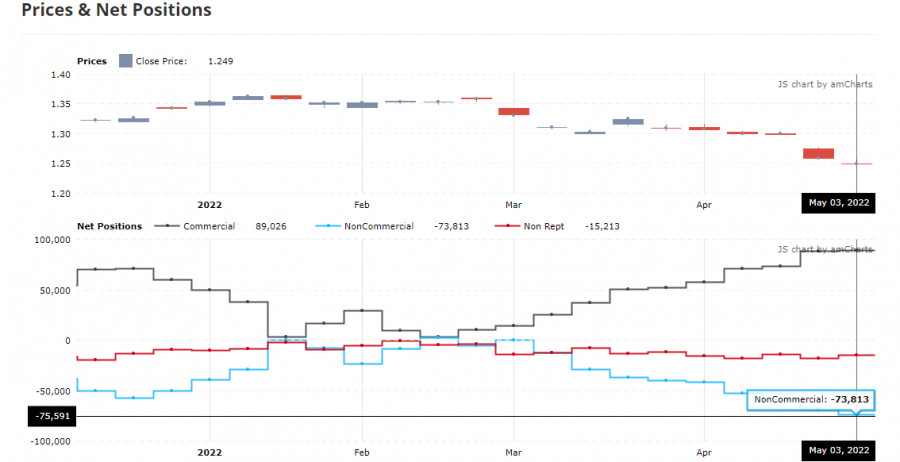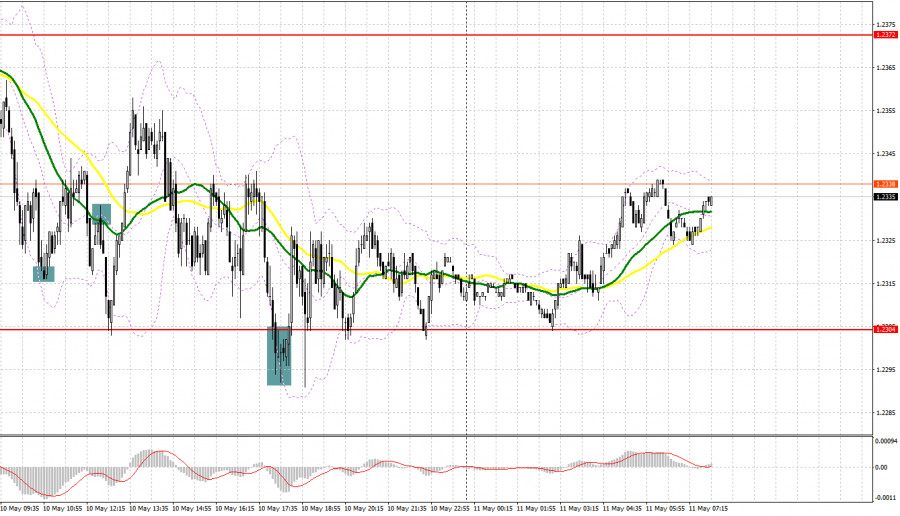
When to go long on GBP/USD:
A few good trading signals were produced yesterday. However, not all of them turned out to be profitable. Let's turn to the M5 chart and analyze the situation. In my previous overview, I paid attention to the 1.2328 level and suggested it would be a nice entry point. A false breakout of the mark during the European session created a nice buy signal. However, nothing happened as pressure on the pair returned after the price had increased by 10 pips. The second false breakout at 1.2328 did not give the desired result, and the pound showed no powerful rebound. A sell signal followed by a fall of 30 pips occurred after a breakout and a retest of the 1.2328 mark. During the North American session, bears pushed the pair to new support at 1.2304. After a false breakout there, a buy signal was made. Unfortunately, demand for the pound decreased after a 10 pips rebound, and GBP descended.

Before we analyze the technical picture of GBP/USD, let's take a look at the futures market. The Commitments of Traders report for May 3 logged a decrease in both short and long positions. As a result, the negative value of non-commercial net positions grew. The British economy is now going through tough times, which makes investors cautious about the pound. In light of the US Fed's aggressive moves, the greenback will continue strengthening and the pound will keep on falling. A slight decrease in inflationary pressure in the US may lead to a bullish correction in the market. The Bank of England's recent rate hike has had no positive effect on the economy so far due to high inflationary pressure in the country. Governor Andrew Bailey has recently announced that the British economy might soon enter a recession. So, we might not expect the pound to rise any time soon. The situation could only get worse as future inflationary risks are now hard to assess because of ongoing geopolitical developments. One thing is clear, consumer prices will keep on rising in the coming months. As for the UK labor market, employers have to fight for every employee offering higher wages, which is only driving inflation further up. According to the COT report from May 3, long non-commercial positions fell by 6,900 to 33,536. Short non-commercial positions dropped by 2,708 to 107,349. As a result, the negative value of non-commercial net positions grew to -73,813 from -69,621. The weekly closing price dropped to 1.2490 versus 1.2587.

Yesterday, the technical picture did not change. The pound retraced up slightly. Since no macro events are to unfold in the UK today, we might expect a rise to 1.2372. However, the US inflation report might trigger market jitters. Therefore, volatility could be at a relatively low level during the European session. Now, in case the pair is bearish, a false breakout at 1.2304 will make a buy signal, and GBP/USD will remain in the sideways channel. However, given the state of the British economy, bears will clearly be more active whenever the pair retraces up. An additional buy entry point will be created after a false breakout at 1.2372 and its retest from top to bottom. If so, demand for the pound will increase and the quote will head towards 1.2505, where you should consider profit taking. Anyway, the pair will reach this level if major players close positions after the release of the US inflation report. In case of bearish GBP/USD during the European session and a decrease in activity at 1.2304, you may look for buy entry points from the yearly low of 1.2261. In case of a false breakout there, the downtrend could stop, and an entry point would be created, allowing a short-term upward correction. Long positions on GBP/USD could also be entered on a bounce off 1.2185, or even lower, off 1.2122, allowing a 30-35 pips intraday correction.
When to go short on GBP/USD:
The US inflation report might cause turmoil in the market today. Therefore, it is important to be extra careful when going short on the pound today. As long as the pair trades in the sideways channel near the moving averages, volatility will be at a low level. Should the pound leave the cannel, traders will become more aggressive. That is why bears should protect the range of 1.2372. A false breakout of the mark will produce a sell entry point with targets at 1.2304 – the middle of the sideways channel – and 1.2261 – the yearly low. GBP/USD will plunge to the lows of 1.2261 and 1.2185 if the quote breaks through 1.2304 and tests the mark from bottom to top. A more distant target stands at 1.2122, where you should consider profit taking. In the event of bullish GBP/USD during the European session and a decrease in bearish activity at 1.2372, you may look for sell entry points after a false breakout at 1.2441. Short positions on GBP/USD could also be entered on a bounce off the 1.2505 high, allowing a 30-35 pips downward correction intraday.
Moving averages
Trading is carried out in the range of the 30-day and 50-day moving averages, which indicates a sideways market.
Note: The period and prices of moving averages are viewed by the author on the hourly chart and differ from the general definition of classic daily moving averages on the daily chart.
Bollinger BandsThe lower band at 1.2304 stands as support. Resistance is seen at 1.2340 in line with the upper band.
Indicator descriptionMoving average (MA) determines the current trend by smoothing volatility and noise. Period 50. Colored yellow on the chart.Moving average (MA) determines the current trend by smoothing volatility and noise. Period 30. Colored green on the chart.Moving Average Convergence/Divergence (MACD). Fast EMA 12. Slow EMA 26. SMA 9.Bollinger Bands. Period 20Non-commercial traders are speculators such as individual traders, hedge funds, and large institutions who use the futures market for speculative purposes and meet certain requirements.Long non-commercial positions are the total long position of non-commercial traders.Non-commercial short positions are the total short position of non-commercial traders.Total non-commercial net position is the difference between short and long positions of non-commercial traders.